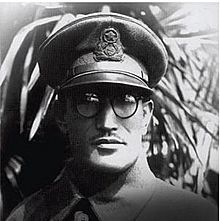Lee Beom-seok (prime minister) facts for kids
Quick facts for kids
Lee Beom-seok
|
|
|---|---|
| 이범석 | |
 |
|
| 1st Prime Minister of South Korea | |
| In office August 1, 1948 – April 21, 1950 |
|
| President | Syngman Rhee |
| Preceded by | Position established |
| Succeeded by | Shin Sung-mo (acting) |
| Member of the House of Councillors of the Republic of Korea (5th National Assembly) |
|
| In office August 8, 1960 – May 16, 1961 |
|
| President | Yun Po Sun |
| Personal details | |
| Born | October 20, 1900 Hwangseong, Korean Empire (now Seoul, South Korea) |
| Died | May 11, 1972 (aged 71) Seoul, South Korea |
| Spouse | Kim Maria |
| Military service | |
| Allegiance | |
| Korean name | |
| Hangul | |
| Hanja | |
| Revised Romanization | I Beom-seok |
| McCune–Reischauer | Yi Pŏmsŏk |
| Art name | |
| Hangul | |
| Hanja | |
| Revised Romanization | Cheolgi |
| McCune–Reischauer | Ch'ŏlgi |
Lee Beom-seok (October 20, 1900 – May 11, 1972) was a Korean independence activist and the first prime minister of South Korea from 1948 to 1950. He also headed the Korean National Youth Association (조선민족청년단, 朝鮮民族靑年團). His nickname was Cheolgi.
Biography
Lee Beom-seok was born in Gyeongseong (now Seoul) on October 20, 1900. Lee's father was an officer in the Joseon Dynasty and he was a descendant of Sejong the Great's son 'Gwangpyeong Daegun (Hangul: 광평대군; Hanja: 廣平大君)'. Lee Beom-seok was exiled to the Republic of China after participating in independence activities as a teenager. In 1919, he started studying at the Shinheung military academy (Hangul: 신흥무관학교; Hanja: 新興武官學校), a military school whose goal was to build a new army to fight for independence. Soon after, Lee fought in the Battle of Cheongsanni, a six-day engagement in eastern Manchuria. He later served as a general in the Korean Liberation Army for the Provisional Government of the Republic of Korea.
In 1945, Lee attempted to return to Korea but was forced to remain in exile in China. In 1946, he returned to Korea and helped found the Korean National Youth Association with Ahn Ho-sang. He was opposed to Kim Gu's South-North negotiations (Hangul: 남북협상; Hanja: 南北協商) and allied himself with Lee Syng-man to establish a unitary government in South Korea. He served as the new country's first prime minister from July 31, 1948 to April 20, 1950.
Later life and death
Following his term in office, Lee Beom-seok served as the Korean Ambassador to the Republic of China, and as Secretary of the Interior. He ran for the vice presidency in 1952, and again in 1956, but failed to win either election. Throughout the 1960s, he remained a staunch opposition leader to the ruling party. At the end of his career, Lee served as an adviser on the Board of National Unification (Hangul: 국토통일원; Hanja: 國土統一院) and mentored Park Chung-Hee as an elder of the nation.
On May 10, 1972, he was granted a philosophy doctorate by the Taiwan Chinese Academy. The following day, May 11, he died of a myocardial infarction in the Seongmo hospital of Myeong-dong in Seoul. His state funeral was held in the Square of Namsan Mountain on May 17, and he was buried in Seoul National Cemetery.
Posthumous work
- Udungbul (Korean: 우둥불)
- Bangrangui Jeong-yeol (Passion of Wandering) (Korean: 방랑의 정열)
- Hangug-ui Bunno (Rage of Korea) (Korean: 한국의 분노)
- Minjok Gwa Cheongnyeon (Nationality and the Youth) (Korean: 민족과 청년)
- Hyeoljeon: Cheongsanni Jakjeon (Bloody battle: Strategy of Cheongsanni) (Korean: 혈전: 청산리 작전)
- Tomsk-ui Haneul Arae (Under the Tomsk's Sky) (Korean: 톰스크의 하늘아래)
See also
 In Spanish: Lee Beom-seok para niños
In Spanish: Lee Beom-seok para niños
- Fascism in Asia
- Ilminism
- Korean National Youth Association
- Korean independence movement
Site web
- Lee Beom-seok Memorial museum
- Lee Beom-seok
| Preceded by N/A |
Prime Minister of South Korea 1948–1950 |
Succeeded by Shin Sung-mo (acting) |
| Preceded by N/A |
Defense minister of South Korea 1948–1949 |
Succeeded by Shin Sung-mo |
| Preceded by Chnag Seok-yun |
Interior Minister of South Korea 1952 |
Succeeded by Kim Tae-sun |

